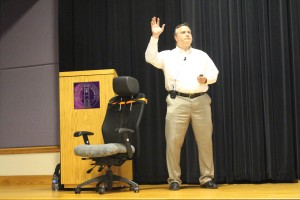
Peter Freer explaining the technology behind the patented headrest at WCU on Oct. 24, 2016. Photo by Matt Ober.
Peter Freer, President of Freer Logic, hosted a presentation Oct. 24 on Western Carolina University Campus titled Yes. We Can Read Your Mind.
The event was held in the University Center Theater from 4 to 5 p.m., and had the purpose of presenting some of the sensory technology that Freer Logic has been making advances in.
“We want to try to implement this technology in cars so that every car can communicate on the road,” said Freer while he was demonstrating.
The most impressive way that Freer presented his technology to the audience was bringing in a regular office chair, and attaching a specially designed headrest to it.
“The headrest has the ability to monitor the users’ brainwaves, and can help the driver remain in control of his vehicle,” Freer explained.
Freer then had a couple random members of the audience come up to the stage to test the device. He played a driving simulator/video for the test subject, and the video would only play when the driver was focused and using 50% of their attention span on actually “driving.” If the driver failed to do this, the video would stop momentarily and say “Driver distraction detected.” So naturally, Peter tried to distract the “drivers” and had them perform activities such as texting and driving. It was very impressive as the audience was able to see in real time how focused the person on the stage was.
“This technology would also be able to see if the driver is becoming sleepy before the driver is even able to feel the drowsiness themselves, and then send a message to the car to tell the driver that they are feeling sleepy, as well as recommend hotels nearby for the driver to stop,” Freer included.
Near the end of the demonstration, Freer opened up the floor for people to ask questions. Some had questions of the technology itself, “Does the machine need to be calibrated with each new person who interacts with it.” One person asked. To which Freer replied “No. The machine does not need a constant for it to determine someones brainwaves. So it is automatically able to calibrate itself.” However, only a couple of people asked questions during the presentation.
Freer concluded with a very excited audience. “This technology is already being implemented. Some of it is available now, some of it to become available in the near future. Within a couple of years.”


